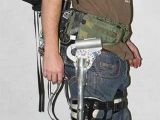A soldier's main enemy is his own backpack. The same issue is faced by hikers, firefighters and other heavy load carriers, often over rough terrain, where vehicles cannot enter. Hauling is not an option, as it decreases mobility.
A team at M.I.T. Media Lab's Biomechatronics Group has made an exoskeleton that not only could unburden travelers but also lead to the development of stronger and more mobile robotic limbs, closer to real human movements. The M.I.T. exoskeleton is also lighter and consumes less energy than similar technologies do.
"When a person walks, there's an exchange of energy within the body that allows for an efficient movement pattern. We attempted to build a lighter and lower power exoskeleton exploiting humanlike passive dynamics," said Hugh Herr, Biomechatronics's principal investigator and associate professor in the Media Lab.
The M.I.T. exoskeleton attaches to boots connected to tubes parallel to the feet that go through them to a backpack and is powered by a 48-volt battery pack, controlled by an onboard computer, and weighs just 11.7 kilograms (26 pounds). It works at two watts of electrical power for loaded walking. The exoskeleton takes payload from the user's back to the ground; it includes elastic energy storage pieces at the hip and ankle, and a variable-damping device at the knee.
Herr would like to develop a "biohybrid" prosthetic leg, whose movements would be controlled by the user's brain. "My dominant area of interest is the treatment of leg pathologies," said Herr, who lost both of his lower legs because of a frostbite 25 years ago during a climb on New Hampshire's Mount Washington.
His team presented in July 2007 the first prosthetic ankle imitating the functioning of a human ankle, permitting a natural gait for patients whose leg has been amputated below the knee. The robotic ankle is powered by a rechargeable battery, and uses forward using sensors and tendon-like springs, eliminating the hip's work of drawing the foot forward, as in the case of most prostheses.
The Exoskeleton's development has been hampered by various issues, like how to develop a device that does not impede the user's normal walk and which runs on a small battery-powered pack, not fuel.
During MIT exoskeleton's tests, even if the back loads were lighter, walking required increased exertions, and the user increased oxygen consume by 10 % compared to free walk.
A team at Berkeley Bionics and the University of California have also developed two exoskeletons: for walking - the ExoHiker and for climbing, the ExoClimber. In 2008, a new exoskeleton will combine walking and climbing abilities.
This technology could be employed by the Defense Department. ExoHiker can carry weights of up to 70 kg (150 pounds) during long military actions, and function up to 65 km (42 mi) at a medium speed of 4 km per hour (2.5 mph), powered just by a one-pound (0.4 kg) lithium polymer battery. A solar panel would allow unlimited functioning, while the soldier's oxygen consumption decreases by 15 %.
ExoClimber can rapidly climb stairs of 185 m (600 ft) and steep slopes carrying loads reaching 70 kg, being powered by the same one-pound battery. "Our focus has been to make a practical machine that can be used for the Defense Department's forces. In the future Berkeley Bionics's technology may also be used to help patients learning to walk again after serious injuries.", said Homayoon Kazerooni, chief scientist for Berkeley Bionics and a professor of mechanical engineering at U.C. Berkeley's Robotics Laboratory.

 14 DAY TRIAL //
14 DAY TRIAL // 
